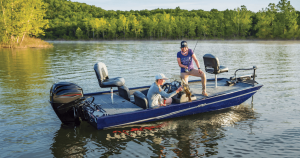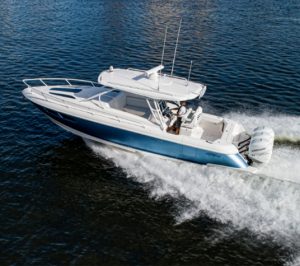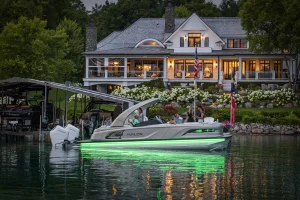Inflatable Boats: A Comprehensive Guide for Buyers
Inflatable boats have gained popularity in recent years due to their versatility, portability, and affordability. These lightweight watercraft are an excellent choice for recreational activities, like fishing and exploring, as well as rescue operations and military use.
Constructed from durable materials such as PVC or Hypalon, inflatable boats come in various sizes and designs, including roll-up, RIB (rigid inflatable boats), and catamaran styles. Some manufacturers, like 3D Tender and Zodiac Nautic, have built a reputation for producing high-quality inflatable boats that cater to a variety of needs.
Types of Inflatable Boats
Inflatable boats come in various styles and designs, each offering unique features to suit different water activities. Some of the most common types of inflatable boats include:
- Inflatable pontoon boats
- Inflatable kayaks
- Roll-up boats
- Inflatable canoes
- Inflatable rafts
An inflatable pontoon boat typically consists of two inflatable tubes connected by a metal, plastic, or wooden frame. They provide a stable platform for fishing, diving, or cruising and often come with comfortable seating arrangements.
Inflatable kayaks are highly portable and easy to store, making them an ideal choice for recreational paddlers, anglers and campers. They come in various designs and sizes, including single, tandem, and fishing-specific models.
Roll-up boats are lightweight and can be easily folded for storage and transportation. They feature a slatted or flexible floor, making them a popular choice for general water activities, yacht tenders and beach excursions.
Inflatable canoes have a similar design to traditional canoes, typically accommodating two or three passengers. Their inflatable nature makes them lightweight and more manageable on the water.
Lastly, inflatable rafts are designed for various uses, including recreational, commercial, and rescue operations. They come in different shapes and sizes and can be outfitted with numerous accessories, such as paddles or a motor.
Materials and Construction
Inflatable boats are constructed using various materials and techniques to provide durability, stability, and convenience. Two of the most common materials used in their manufacturing are CSM (chlorosulfonated polyethylene) and Neoprene. CSM is a rubber-like material with excellent resistance to various environmental factors.
Another popular material for inflatable boats is PVC (polyvinyl chloride), a plastic polymer that offers flexibility, affordability, and resistance to punctures. Some high-quality inflatable boats are also made using materials from trusted manufacturers like Mehler Technologies and Heytex.
Inflatable boats are assembled using specially cut fabric shapes to create seams that join the tubes and other attachments to each other. The material of these seams can play a crucial role in the boat's durability and overall performance. Many inflatables utilize a technique called heat-welded seams, which can provide a stronger bond than traditional methods like gluing or sewing.
Some of the essential features to consider when looking at the construction of an inflatable boat include:
- Air chambers: The number and design of air chambers can affect the boat's stability, buoyancy, and safety.
- Floor type: Inflatable boats can come with a variety of floor types, such as rigid, slatted, or inflatable models, each with their benefits and drawbacks.
- Transom and motor mount: These components need to be sturdy and reliable to support the weight and operation of outboard motors.
In conclusion, the materials and construction of inflatable boats play a significant role in the overall performance, durability, and functionality of these versatile vessels.
Advantages and Disadvantages of Inflatable Boats
Inflatable boats come with various advantages and disadvantages that potential buyers should be aware of when making their decision. Here, we'll discuss some of the key benefits and drawbacks associated with these vessels.
Advantages:
- Easy to store: Inflatable boats can be easily deflated and stored in a small space, like at home or in a car trunk, giving them a space-saving advantage over solid boats. (source)
- Easy to transport: Due to their lightweight nature, inflatable boats can be transported without requiring a trailer or large vehicle. (source)
- Stability: Inflatable boats generally have high stability, thanks to their inflatable components, which provide a cushioning effect and minimize lateral rolling. (source)
- Fuel Efficiency: Their lightweight design reduces fuel consumption compared to heavier, solid boats. (source)
Disadvantages:
- Life Expectancy: Inflatable boats have a shorter lifespan than solid fiberglass boats, with some PVC models lasting for less than five years. (source)
- Maximum Allowable Load: Inflatable boats typically have a lower maximum allowable load than solid boats, which can limit their usage for heavy lifting or carrying large groups of passengers. (source)
Usage Scenarios
Inflatable boats are versatile watercraft that cater to various use cases. This section will outline some of the popular usage scenarios where these boats excel.
Recreational Activities: One of the primary uses of inflatable boats is for leisure and water sports. These boats provide an accessible and affordable option for families and individuals to enjoy activities such as fishing, cruising, and exploring waterways. Inflatable boats are easy to launch and offer convenient storage, making them a favorite among recreational boaters. For more info, refer to BoatsToGo.
Emergency and Rescue Operations: The lightweight and portable nature of inflatable boats makes them ideal for emergency services and search-and-rescue operations. They are quick to deploy and maneuverable in tight spaces or shallow water, allowing rescuers to reach those in need without delay.
Military and Law Enforcement: Inflatable boats are frequently employed in military and law enforcement applications. Their portability, stability, and durability allow them to perform tasks like surveillance, transportation, and rapid deployment in maritime security operations.
Dinghies and Tenders: Inflatable boats can serve as dinghies or tenders for larger vessels. Their portability enables them to be carried on board and used for transportation between the main vessel and the shore or other nearby locations.
River Rafting and Whitewater Adventures: With their robust construction and ability to navigate rapids, inflatable boats are well-suited for river rafting and whitewater adventures. Many outfitters rely on inflatable boats to take thrill-seekers on exciting and safe river expeditions. For more details on different boat types and their technical specs, visit Navigator Boat.
Maintenance and Storage
Inflatable boats require regular care and maintenance to ensure a long life and peak performance. Proper cleaning, protection, and storage are essential aspects of inflatable boat maintenance.
After each use, it is crucial to clean the boat thoroughly with fresh water and mild soap to remove any dirt, debris, or saltwater residue. This will help prevent material degradation and prolong the lifespan of the boat. For heavy stains, you can use specialized inflatable boat cleaners such as Red Beard's Inflatable Boat Cleaner.
To keep your inflatable boat in good condition, it's essential to inspect it regularly for any signs of wear, leaks, or damage. Minor repairs can often be done using repair kits designed specifically for inflatable boats. Make sure to check the manufacturer's recommendations for repairs and maintenance.
| Maintenance Tasks | Frequency |
|---|---|
| Cleaning | After each use |
| Inspecting for leaks or damage | Once a month or before long trips |
| Storage Preparation | Before storing, at the end of the season |
Proper storage greatly impacts the longevity of an inflatable boat. Ensure that the boat is completely dry before storing, as moisture can cause mold and mildew growth. Store your boat in a cool, dry, and ventilated area away from direct sunlight and pests, such as rodents. Some people prefer to partially deflate the boat to protect against temperature fluctuations and save storage space, while others keep their boats inflated in a well-ventilated storage room to minimize stress on the seams and fabric. Always consult the manufacturer's recommendations for optimal storage conditions.
During the winter or longer storage periods, it is essential to follow additional precautions, such as protecting the boat with a boat cover and using a proper winterizing procedure. For more tips on storing your boat, you can refer to the Navigator Boat guide.
Safety Tips
Inflatable boats are a popular choice because of their safety and ease of use. However, it is still important to follow safety guidelines to ensure a pleasant experience on the water. Here are some safety tips for using inflatable boats:
1. Learn the Basics of Boat Operation
Before taking your inflatable boat out on the water, you should learn the ins and outs of operating it. This can help you confidently navigate, manage your boat's speed, and avoid potential hazards. You can find resources to help you learn about inflatable boat operation at websites like Sirocco Marine.
2. Don't Overcrowd Your Boat
It's important not to exceed the maximum capacity of your boat. Overcrowding can result in poor stability and could increase the risk of an accident. Ensure that passengers remain seated and avoid sitting on the buoyancy tubes at high speeds (All Inflatables).
3. Assign a Designated Helper
Having someone on board who can assist you in the event of an emergency is a good idea. This person should be familiar with your boat's operation and capable of providing additional support while you focus on managing the situation.
4. Be Aware of Water Conditions and Weather
Always check the weather forecast and water conditions before heading out. Inflatable boats can be affected by strong winds, currents, and choppy waters, so it's important to be prepared and adjust your plans if needed.
5. Ensure Your Boat is Puncture-Proof
Quality inflatable boat manufacturers run rigorous tests to ensure their boats are puncture-proof (Stryker Boats). However, it is still essential to be cautious not to drag the boat on rough surfaces and always carry necessary repair materials in case of a puncture.
6. Bring Essential Safety Equipment
Some essential safety items you should bring on a boat trip include life jackets, a first aid kit, a whistle or horn, a marine VHF radio, and a GPS device. Always make sure to have enough life jackets for every passenger.
Buying Guide
When choosing an inflatable boat, the right one depends on your intended use, motor options, and passenger capacity. In this section, we will guide you through some essential features to look out for when purchasing an inflatable boat.
Type of Inflatable Boat
There are several types of inflatable boats to suit different needs. Consider which one is most appropriate for your intended use:
- Rigid Inflatable Boats (RIB): Heavy-duty and versatile, suitable for swimming, fishing, and more
- Inflatable Canoe: Designed for two to three passengers, ideal for calm waters
- Inflatable KaBoats: A hybrid between a kayak and boat, accommodating various water activities
- Sport Inflatable Boats: Smaller vessels designed for recreational use and easy transportation
Material
Different materials impact durability, weight, and overall resilience. The following materials are commonly used in inflatable boats:
| Material | Advantages |
|---|---|
| PVC (Polyvinyl Chloride) | Cost-effective, lightweight, and easy to maintain |
| Hypalon |
Highly resistant to UV rays, chemicals, and extreme temperatures, making it durable and long-lasting
|
Passenger Capacity and Dimensions
Consider the size and passenger capacity of the inflatable boat. Smaller-sized boats and canoes have limited seating options, while larger vessels can accommodate more people and gear.
Motor Options
Finally, review motor options available for your specific inflatable boat choice. Some boats may require an electric or gas-powered engine, while others function with oars or paddles. The Inflatable Boat Buyers Guide at Newport Vessels offers additional guidance on selecting the right motor based on your boat choice.
Conclusion
Inflatable boats have become increasingly popular due to their unique advantages over traditional rigid boats. The flexibility and cost-effectiveness make them an appealing choice for various applications, from recreational use to professional service. The combination of lightweight materials, such as PVC and Hypalon (CSM), with a rigid hull design provides a versatile and practical solution for on-water transportation.
As noted in various sources, the lifespan of an inflatable boat varies depending on various factors. Newport Vessels reports PVC inflatable boats can last between 2-10 years based on the manufacturer, use, and care, while Hypalon boats typically have a longer lifespan.
When considering the purchase of an inflatable boat, it is essential to weigh the advantages and drawbacks of available options. It is important to select a boat that meets your specific needs and is constructed of high-quality materials to ensure you get the most out of your investment.
In conclusion, inflatable boats offer a unique blend of performance, flexibility, and cost-effectiveness ideal for various boating needs. With the growing popularity of these vessels, continued advancements in material and construction technology are likely to further enhance their usability and reliability.











